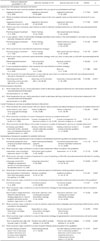This article has been corrected. See "Erratum: Multidisciplinary Approaches in Developing Guideline for Mediating Behavioral Problems in Children and Adolescents with Neurodevelopmental Disorders" in Volume 57 on page 274.
Abstract
Objectives
To initiate and develop a treatment guideline in multidisciplinary approaches for related professions who are either working and/or living with children and adolescents with neurodevelopmental disorders who show behavioral problems.
Methods
To collect and reflect opinions from multiple professions who assumedly have different interventions or mediations on behavioral problems, a self-report survey and Focus Group Interview (FGI) were conducted for a group of child and adolescent psychiatrists, behavioral therapists, special education teachers, social welfare workers, and caregivers.
Results
According to a self-report survey and FGI results from multiple professional groups, aggressive behavior is the mostly common behavioral problem necessitating urgent interventions. However, both mainly used intervention strategies and effective treatment methods were different depending on professional backgrounds, such as pharmacological treatment, parent training, and behavior therapy, even though they shared an importance of improving communication skills. In addition, there was a common understanding of necessity to include parent training in a guideline. Lastly the data suggested lack of proper treatment facilities, qualified behavior therapists, and lack of standardized treatment guideline in the field needed to be improved for a quality of current therapeutic services.
Conclusion
It is supported that several subjects should be included in the guidelines, such as how to deal with aggressive behavior, parent training, and biological aspects of neurodevelopmental disorders. Also, it is expected that publishing the guideline would be helpful to above multiple professions as it is investigated that there are lack of treatment facility and qualified behavioral therapists compared to need at the moment.
Figures and Tables
Table 1
Estimated number and rate of increase of disabled person in Korea

Statistics : Actual condition survey of disabled person (2014, Korea Institute for Health and Social Affairs)1)
References
1. Kim SH, Lee YH, Hwang JH, Oh MA, Lee MK, Lee NH, et al. Year survey of disabled people. Seoul: Korea Institute for Health and Social Affairs;2014. p. 109–124.
2. Matson JL, Kozlowski AM. The increasing prevalence of autism spectrum disorders. Res Autism Spectr Disord. 2011; 5:418–425.

3. Newschaffer CJ, Croen LA, Daniels J, Giarelli E, Grether JK, Levy SE, et al. The epidemiology of autism spectrum disorders. Annu Rev Public Health. 2007; 28:235–258.

4. Doehring P, Reichow B, Palka T, Phillips C, Hagopian L. Behavioral approaches to managing severe problem behaviors in children with autism spectrum and related developmental disorders: a descriptive analysis. Child Adolesc Psychiatr Clin N Am. 2014; 23:25–40.

5. Yoon CY. Understandings of developmental disorder: concepts, causes, prevention and diagnostic criteria. Seoul: Hyeongseol Publishing Co.;2003.
6. Horner RH, Carr EG, Strain PS, Todd AW, Reed HK. Problem behavior interventions for young children with autism: a research synthesis. J Autism Dev Disord. 2002; 32:423–446.
7. law.go.kr [homepage on the Internet]. The law about protection of right and support for people with developmental disorder. National Law Information Center;cited 2017 Nov 3. Available from: http://www.law.go.kr/lsInfoP.do?lsiSeq=188089&efYd=20170603#0000.
8. en.wikipedia.org [homepage on the Internet]. Evidence-based practice. cited 2017 Nov 3. Available from: https://en.wikipedia.org/wiki/Evidence-based_practic.
9. ncmh.go.kr [homepage on the Internet]. Treatment guideline for behavioral problem of children and adolescents with neurodevelopmental disorders. National Center for Mental Health;cited 2018 Apr 24. Available from: http://www.ncmh.go.kr/kor/notice/commonNoticeView2.jsp?no=2444&fno=112&depart=0&pg=1&search_item=0&search_content=&menu_cd=K_04_08_00_00_T0.




 PDF
PDF ePub
ePub Citation
Citation Print
Print





 XML Download
XML Download